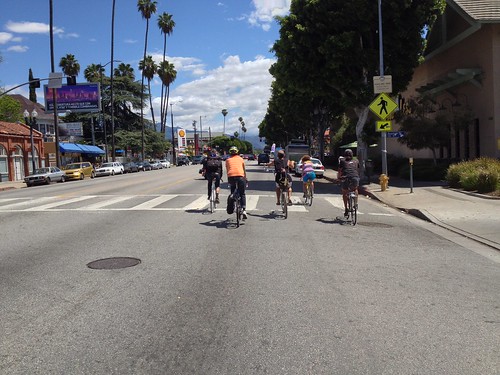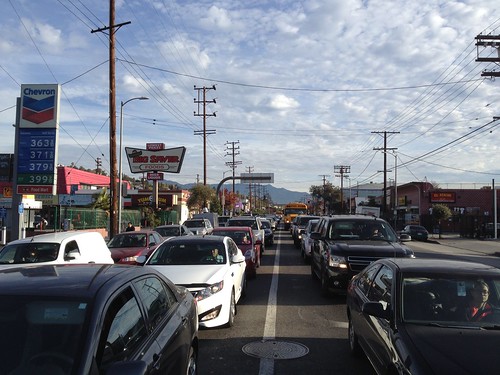At 9:45pm on Friday, September 18th, pedestrian Yolanda Lugo, 51 was struck by a driver as she was walking in the crosswalk located at Figueroa and South Avenue 55 in Highland Park. The driver failed to yield, and fled the scene. After two days in intensive care, Yolanda Lugo lost her life on Sunday, September 20th.
According to the news media and witnesses, as drivers yielded in the other lanes, the driver of a white Mitsubishi Lancer traveling north in the number two northbound lane passed the car yielding in the number one northbound lane just as Yolanda Lugo stepped into his path. Her body was thrown 50 feet up Figueroa, landing near the parking lot of the Auto Zone parts store. The driver kept going; speeding away north on Figueroa until eventually stopping briefly in Garvanza near York Boulevard and Avenue 66 to remove his license plates before disappearing into the night. Police have since located the vehicle involved, and know the identity of the driver who remains at-large. Thanks to CD 15 council member, Joe Buscaino, as of April, the City of Los Angeles has a standing reward for all Hit and Runs, including $50,000 for the capture of Lugo’s killer. (This new law came in-part because constituents previously had to ask their council members to offer a city reward every time someone was killed in a hit and run collision. You may recall in September 2014, the Highland Park community had to practically beg Gil Cedillo for weeks before he would ask city council to support a city reward for the hit-and-run that killed 57-year-old, Gloria Ortiz on Avenue 50.)
https://twitter.com/mennake/status/646867902277136384
By Monday after Lugo’s passing, a couple of prayer candles and some flowers could be seen at the crash site. Word started to get out about her death and her family, with the support of the Highland Park community, began planning a demonstration and vigil for Lugo at the deadly Figueroa crosswalk on Friday, exactly one week after she was fatally struck.
On Friday, September 25th, Fig For All joined the family and friends of Yolanda Lugo at Figueroa and Avenue 55 to vigil, demonstrate, and help raise funds to defray the cost of her medical bills and funeral.
The night of the vigil and demonstration, a week after Lugo was struck and with the perpetrator on the run, Gil Cedillo had yet to acknowledge the event. His Communications Deputy, Fredy Ceja only hinted at the road safety issue with a stop sign blurb in the unusually late publishing of the Cedillo Weekly. Two stop signs in all of Council District 1 were installed recently, both in Highland Park. One installed on Avenue 50 at Lincoln (thanks in large part to Team Huizar’s urging), and another at Marmion Way where it ends at Joy Street. (Yes, they took the opportunity to pat themselves on the back for getting a stop sign installed where a street ends.) It would not be until the next week before Cedillo would comment on the tragedy.
After calling on his office for eleven days, Cedillo finally made a public statement on this latest tragedy and uses the opportunity to scold safety advocates. While he was politically grandstanding, pacifying seniors, doing photo ops, making speeches, having to dinner with police, having dinner with business people, receiving rewards, and wishing his unqualified Planning Deputy a happy birthday, police and community members were lighting-up media outlets and the internet in an effort to get out the story about the hit-and-run and the vehicle involved. While Cedillo was accepting campaign contributions, the community was busy raising funds to defray Yolanda Lugo’s medical and funeral costs. In the time it took for Cedillo to get around to mentioning the hit and run one block from his Highland Park field office, the suspect could have walked from Figueroa to Bahía de los Ángeles, Mexico. If Cedillo really cared he would have been reaching-out to the victims, the police, and the community if not the day after, at least by the Monday after. But no, it took him eleven days, and only after community and media attempts at reaching him.
When he does respond to this latest tragedy, he once again lashes-out at his critics for as he puts it, “Trying to turn this situation into a political opportunity.” Coincidentally, The Onion put out a story this week that works just as well for Cedillo’s scolding of safety advocates, “Man Can’t Believe Obama Would Use Tragedy To Push Anti-Tragedy Agenda.” Yes, Cedillo. We are as you say, “Trying to turn this situation into a political opportunity.” Yes, we will use this tragedy to push our anti-tragedy agenda. We want you to do the right thing, we want you to stop this ridiculous brinkmanship and allow LADOT to install safety enhancements.
Just three weeks before Lugo was fatally struck on Figueroa, Mayor Eric Garcetti signed his Executive Directive making Vision Zero city policy. North Figueroa, the Deadliest Street in Northeast L.A., is well on its way to becoming the test-case for the city’s goal of reducing traffic deaths to zero by 2025. That aspect is explored in this story by Meghan McCarty at KPCC. At the same time as Los Angeles is trying to achieve Vision Zero, the State of California is trying to bring an end to its rampant hit-and-run epidemic. On October 2nd, both Eastern Group Publications, and La Opinión cover the Lugo tragedy with an emphasis on Assemblyman Mike Gatto‘s new law to create a Hit and Run Yellow Alert system for California.
Meanwhile, still backpedaling driving in reverse, Team Cedillo miraculously “Secures” funding left over from the Reyes administration to install crosswalk signals on Figueroa.

Highland Park CD1 Field Deputy, Malinda Alatorre’s tired picture of a beg button from back in May highlights the “Safety Updates” in the Cedillo Weekly e-Newsletter. Amazing how quickly they “Find funding” to do safety improvements AFTER someone gets killed by motorists around here.
Remember, when they say, “In the pipeline” that means don’t expect anything to be done anytime soon. (At least not before the 2017 re-election campaign.) If you recall the, “No-I-Will-Not-Make-Figueroa-Safer-Because-Safety” letter from last July, he promised alternative roadway safety enhancements. None of which have been implemented.
For years, Northeast Los Angeles has suffered from a pathetic lack of reliable news coverage. If there is fire, flood or blood in Northeast L.A., we might get coverage. (As of this post, TV news outlets that first reported the Hit and Run have not updated their stories from nearly a month ago.) The one local “Newspaper” we have isn’t even a newspaper, it’s a propaganda rag. Now-retired publisher, Tom Topping started the monthly publication over 18 years ago in an effort to save automotive businesses on Colorado Boulevard in Eagle Rock. New publisher, Colorado Boulevard hardware store owner, Tim Tritch seems to be keeping that same propaganda spirit. Instead of reporting the Hit and Run story and vigil, he just reprinted Gil Cedillo’s letter word for word. What’s worse is, Tim Tritch seems to like Cedillo even more than Tom Topping did. Even the local Arts newspaper, does a better job at reporting local news.

See, this is news. Local news. But in an arts paper, because that is how desperate we are for news coverage.
On Tuesday, October 6th, the family of Yolanda Lugo once again attempted to meet with the Cedillo staff at his Highland Park field office located on Figueroa, one block from the deadly crosswalk. Team Cedillo was gracious enough to meet them outside on the sidewalk. While District Director, Conrado Terrazas seem to take the family’s concerns more seriously, repeating the crossing lights promise, Chief of Staff, and Cedillo’s BFF, Arturo Chavez seemed to consider a family that just lost their sister / their aunt / their mother coming to ask for help A BIG JOKE.
Going to Cedillo’s office, asking for help, and getting the run-around has become de rigueur for Highland Park residents and businesses. Their staff consists of interns, political supporters, and family friends of Cedillo. The hiring process isn’t so much what you know, but who you know, as in, “Do you know Gil?” Qualifying professional degrees and certification seems to be a rarity with them. This has led to a level of mind-numbing ineptitude that is outstanding even by Los Angeles standards. Their administration of CD1 after two years is one of reactionary responses. Never proactive, always trying to shift the blame and make up for their mistakes.
There is some truth to a guy on twitter noting, “If it was a white girl who got ran over the entire nation would be on the hunt, no love no justice for Latinos in Highland Park.”
https://twitter.com/lowkeyx213/status/646563485208330240
A similar situation happened on Rowena Avenue in the more affluent neighborhood of Silver Lake in 2012. 24-year-old Ashley Sandau, was killed by a driver while using the crosswalk on what was then, a four-lane Rowena. The driver did the honorable thing and did not try to flee, so no manhunt was needed. Sandau’s death lead to CD4 council member, Tom LaBonge to order a road diet on Rowena that reduced the road from four multi-use travel lanes to two multi-use travel lanes, one turning lane, and made room to include two bicycle lanes. Pedestrians on Rowena Avenue no longer have to cross in front of four lanes of motor traffic and hope that every driver in every lane sees them. As much as impatient drivers complain, the road diet has made the road safer, and more pleasant for those who live, walk, and bike there.
The problem is we live in Council District 1. We don’t deserve nice things. We don’t deserve the services, the infrastructure, the public safety, or responsiveness that other Los Angeles City Council Districts get. Our Council District 1 council member, Gil Cedillo is a career politician who has thrived on the poverty and desperation of his constituents that kept him in office. That has been his playbook since 1998. Team Cedillo thinks that they can outrun the criticism, that they can say, “We are working on it.” And the public will forget, stop asking and be distracted TV give-a-ways, or another one of his Latin Jazz festivals.
Yolanda Lugo was struck in the crosswalk exactly where a north-bound buffered bike lane was supposed to be installed last year. It is very likely, she would have been in the buffered or bike lane area outside the travel lane where the hit-and-run driver was driving. Figueroa is a wrong-sized and unnecessarily-wide roadway that divides the walking and transit-oriented neighborhoods it passes through. Figueroa needs to be narrowed just as the Department of Transportation has planned. Crossing distances for pedestrians need to be reduced. Visibility for all road users needs be increased. Until Figueroa is fixed, more people will continue to be injured and killed. The question is what number of deaths is Cedillo willing to accept?











































